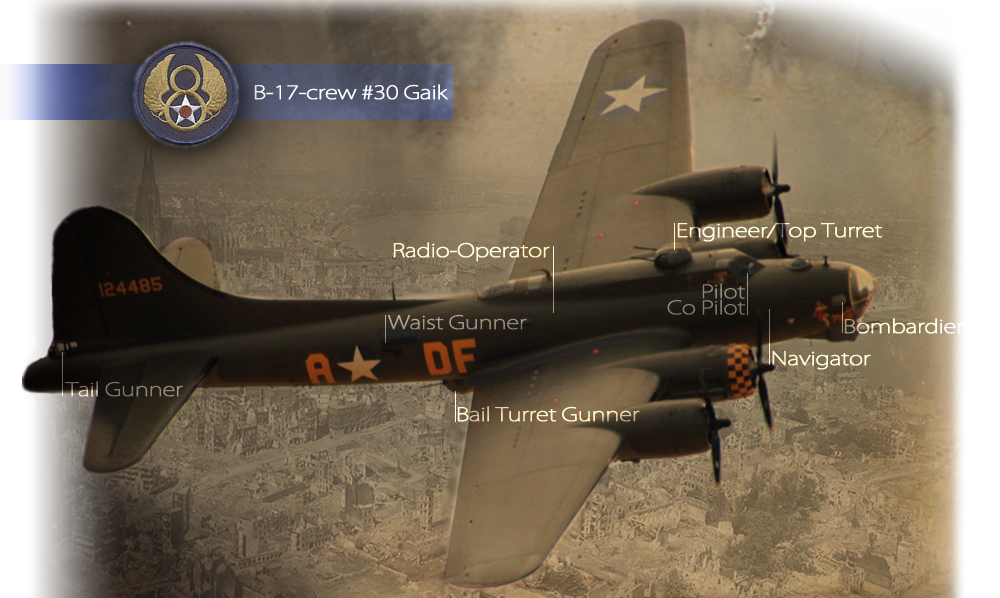[:us]
Navigator:
Air navigation is simply defined as determining the position of an aircraft in relation to the earth. A task far from simple in practice, navigation is a highly exacting art demanding a quick mind and a knowledge of mathematical calculations. A navigator had to know the position of his aircraft at all times, even when guided by a formation-for in war, situations could change rapidly and a crew couldn’t afford not to know where they were over enemy territory. Navigation was the key to avoiding heavily defended areas, reaching the target and returning to base; the pilots flew the plane, but the navigator supplied the course they must fly. Navigation could be by pilotage (visual reference to the ground), dead reckoning (using true airspeed, winds aloft, heading and time to calculate new position from last known), radio, celestial, or any combination of these four.
The navigator’s table was fixed at the rear of the nose compartment, against the left side, behind the bombardier’s station. Above the table were mounted two vital instruments: the gyro- magnetic compass and to its right, the radio compass. The radio compass was linked to a rotating loop antenna inside a tear-shaped housing located just forward of the bomb bay and to a fixed sense antenna, slung along the bottom of the nose. The signal received by these atennas was presented visually on the compass face as a relative bearing to a radio station. On the opposite side from the table was the drift meter. This was used to determine the angle between the heading of the aircraft and its track over the ground. The amount of drift was essential in the calculation of the winds aloft element of dead reckoning.
Throughout the mission the navigator would inform the pilot of their position and time estimates to various check points. When the initial point was reached for the bomb run the navigator would then inform the pilot.
The navigator operated the two cheek guns in the nose when not at his regular duties.
| Flanigan, Harold C
1st LT
|
Navigator
|
|
POW 14-02-1945
Died 26-04-2004
|
[:nl]
Navigator:
Luchtnavigatie kun je eenvoudigweg uitleggen als bepalen van de positie van het vliegtuig in relatie tot de aarde. Een taak echter die in de praktijk niet zo eenvoudig is. Navigatie is een hoogst precieze kunst welke een uiterst snelle geest en kennis van wiskundige berekeningen vereist. Een navigator diende ten alle tijden op de hoogte te zijn van de positie van zijn vliegtuig, ook als hij geleid werd door een formatie voor hem. In oorlog situaties konden snel veanderen en een crew kon zich niet veroorloven niet te weten waar ze zich bevonden boven vijandelijk gebied. Navigatie was de sleutel om stgerk verdedigde plaatsen te mijden, het doelwit te vinden en terug te keren naar de thuisbasis. De piloten vlogen het vliegtuig, maar de navigator bepaalde de route die ze moesten nemen. Navigatie kon plaats vinden via ‘piloting’(positie bepalen visueel ten opzichte van grond), ‘dead reckoning’(nieuwe positie bepalen met nieuwe gegevens ten opzichte van de vorige positie), radio, celestial (astronavigation, of te wel positie bepalen in relatie tot de stand van zon, maan middels hulpinstrumenten) of een combinatie van deze 4 manieren.
De tafel van de navigator stond achter in het neusgedeelte, aan de linkerzijde, achter de positie van de Bombardier. Boven de tafel waren 2 belangrijke, essentiële instrumenten bevestigd: het gyro-magnetische kompas en rechts ervan het radio kompas. Het radio kompas was gekoppeld aan een draaiende lus-antenne in een scheurvormige behuizing vlak voor het bommenluik en aan een antenne aan de onderkant van de neus. De signalen van beide antennes werden zichtbaar op het radio kompas. Aan de overkant van de tafel was een driftmeter. Deze werd gebruikt om de hoek te bepalen van d eneus van het vliegtuig ten opzichte van de grond.
Tijdens de vlucht informeerde de navigator de piloot over hun positie en de tijd tot aan het volgende checkpoint. Als het IP bereikt werd moest de navigatot dit melden aan de piloot.
Tussen de bedrijven door bediende de navigator tevens de 2 Cheek guns, het ‘wang’- geschut aan de zijkant van de neus.
| Flanigan, Harold C
1st LT
|
Navigator
|
|
POW 14-02-1945
Gestorven 26-04-2004
|

